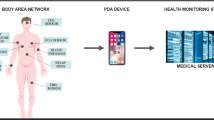Abstract
Wireless body area network (WBAN) is one of the emerging wireless sensor networks for medical applications and treatments with the constrained power of numerous tiny sensors. Nowadays, many of these medical application researches focus on the low-power propagation sensing units in the mesh of the health monitoring system. This article expounds on the applicability of a discrete version of a popular benchmark swarm intelligence algorithm PSO called discrete particle swarm optimization (DPSO) and its hybrid version for energy-optimized WBAN using node coverage. DPSO-based WBAN model optimizes the node coverage for uninterrupted connectivity over the longest possible network life. The network simulator NS-2, for creating WBAN nodes, installation, connection, data transmission in the network environment is used. The simulation results showed that the proposed WBAN model has better performance in the terms of node coverage and network lifespan.
Access this chapter
Tax calculation will be finalised at checkout
Purchases are for personal use only
Similar content being viewed by others
References
Sarkar A, Maunder S (2015) Path loss estimation for a wireless sensor network for application in ship. Int J Comput Sci Mob Comput
Astudy, Haryono T (2016) Novel binary PSO algorithm based optimization of transmission expansion planning considering power losses. In: International conference on innovation in engineering and vocational education, IOP Publishing, IOP Conf. Series: Materials Science and Engineering, vol 128, p 012023. doi:https://doi.org/10.1088/1757-899X/128/1/012023
Dhamodharavadhani S (2015) A survey on clustering based routing protocols in Mobile ad hoc networks. In: 2015 international conference on soft-computing and networks security (ICSNS). doi: https://doi.org/10.1109/icsns.2015.7292426
Sivabalan S, Dhamodharavadhani S, Rathipriya R (2019) Opportunistic Forward routing using bee colony optimization. Int J Comput Sci Eng 7(5):1820–1827. https://doi.org/10.26438/ijcse/v7i5.18201827
Nguyen BH, Xue B, Andreae P, Zhang M, A new binary particle swarm optimization approach: momentum and dynamic balance between exploration and exploitation. IEEE Trans Cybern
Jamil F, Iqbal MA (2019) Adaptive thermal-aware routing protocol for wireless body area network. In: International conference on broadband and wireless computing, communication, and applications
Kaur HP (2015) Cost-based efficient routing for wireless body area networks. Int J Comput Sci Mob Comput
Dhamodharavadhani S, Rathipriya R (2020) Enhanced logistic regression (ELR) model for big data. In Garcia Marquez FP (ed) Handbook of Research on Big Data Clustering and Machine Learning, pp 152–176, IGI Global. http://doi.org/10.4018/978-1-7998-0106-1.ch008
Mohd Kaleem M (2014) Energy consumption using network stability and multi-hop protocol for link efficiency in wireless body area networks. J Comput Eng 16 113:120
Mohamad MS, Omatu S, Deris S, Yoshioka M, Abdullah A, Ibrahim Z (2013) An enhancement of binary particle swarm optimization for gene selection in classifying cancer classes. Algor Molecul Biol 8:1510
Romesh Singh M (2019) Development of efficient multi-hop protocols for wireless body area network. Int J Innov Technol Explor Eng
Sivabalan S, Dhamodharavadhani S, Rathipriya R (2020) Arbitrary walk with minimum length based route identification scheme in graph structure for opportunistic wireless sensor network. Swarm Intell Resour Manage Internet Things 2020:47–63. https://doi.org/10.1016/b978-0-12-818287-1.00006-1
Sivabalan S, Rathipriya R (2017). Slot scheduling Mac using energy efficiency in ad hoc wireless networks. In: 2017 international conference on inventive communication and computational technologies (ICICCT). doi: https://doi.org/10.1109/icicct.2017.7975234
Thangavel K, Bagyamani J, Rathipriya R (2012) Novel hybrid PSO-SA model for biclustering of expression data. Proc Eng 30:1048–1055. https://doi.org/10.1016/j.proeng.2012.01.962
Rathipriya R, Thangavel K (2012) A discrete artificial bees colony inspired biclustering algorithm. Int J Swarm Intel Res 3(1):30–42. https://doi.org/10.4018/jsir.2012010102
Dhamodharavadhani S, Rathipriya R (2020) Variable selection method for regression models using computational intelligence techniques. In Ganapathi P, Shanmugapriya D (ed) Handbook of research on machine and deep learning applications for cyber security (pp. 416–436). IGI Global. https://doi.org/10.4018/978-1-5225-9611-0%2Ech019
Dhamodharavadhani S, Rathipriya R (2021) Novel COVID-19 mortality rate prediction (MRP) model for India using regression model with optimized hyperparameter. J Case Inform Technol (JCIT), 23(4):1–12. https://doi.org/10.4018/JCIT.20211001.oa1
Selvaraj S, Rathipriya R (2019) Energy efficiency in wireless body area networks using path loss model. Int J Comput Sci Eng 7(5):1695–1700. https://doi.org/10.26438/ijcse/v7i5.16951700
Dhamodharavadhani S, Rathipriya R (2018) Region-wise rainfall prediction using mapreduce-based exponential smoothing techniques. In: Advances in intelligent systems and computing advances in big data and cloud computing. 229–239. https://doi.org/10.1007/978-981-13-1882-5_21
Dhamodharavadhani S, Rathipriya R, Chatterjee JM (2020). COVID-19 mortality rate prediction for India using statistical neural network models. Frontiers Public Health 8. https://doi.org/0.3389/fpubh.2020.00441
Author information
Authors and Affiliations
Corresponding author
Editor information
Editors and Affiliations
Rights and permissions
Copyright information
© 2021 The Author(s), under exclusive license to Springer Nature Singapore Pte Ltd.
About this paper
Cite this paper
Selvaraj, S., Rathipriya, R. (2021). Optimizing Node Coverage and Lifespan of Wireless Body Area Network Using Hybrid Particle Swarm Optimization. In: Bindhu, V., Tavares, J.M.R.S., Boulogeorgos, AA.A., Vuppalapati, C. (eds) International Conference on Communication, Computing and Electronics Systems. Lecture Notes in Electrical Engineering, vol 733. Springer, Singapore. https://doi.org/10.1007/978-981-33-4909-4_61
Download citation
DOI: https://doi.org/10.1007/978-981-33-4909-4_61
Published:
Publisher Name: Springer, Singapore
Print ISBN: 978-981-33-4908-7
Online ISBN: 978-981-33-4909-4
eBook Packages: EngineeringEngineering (R0)




